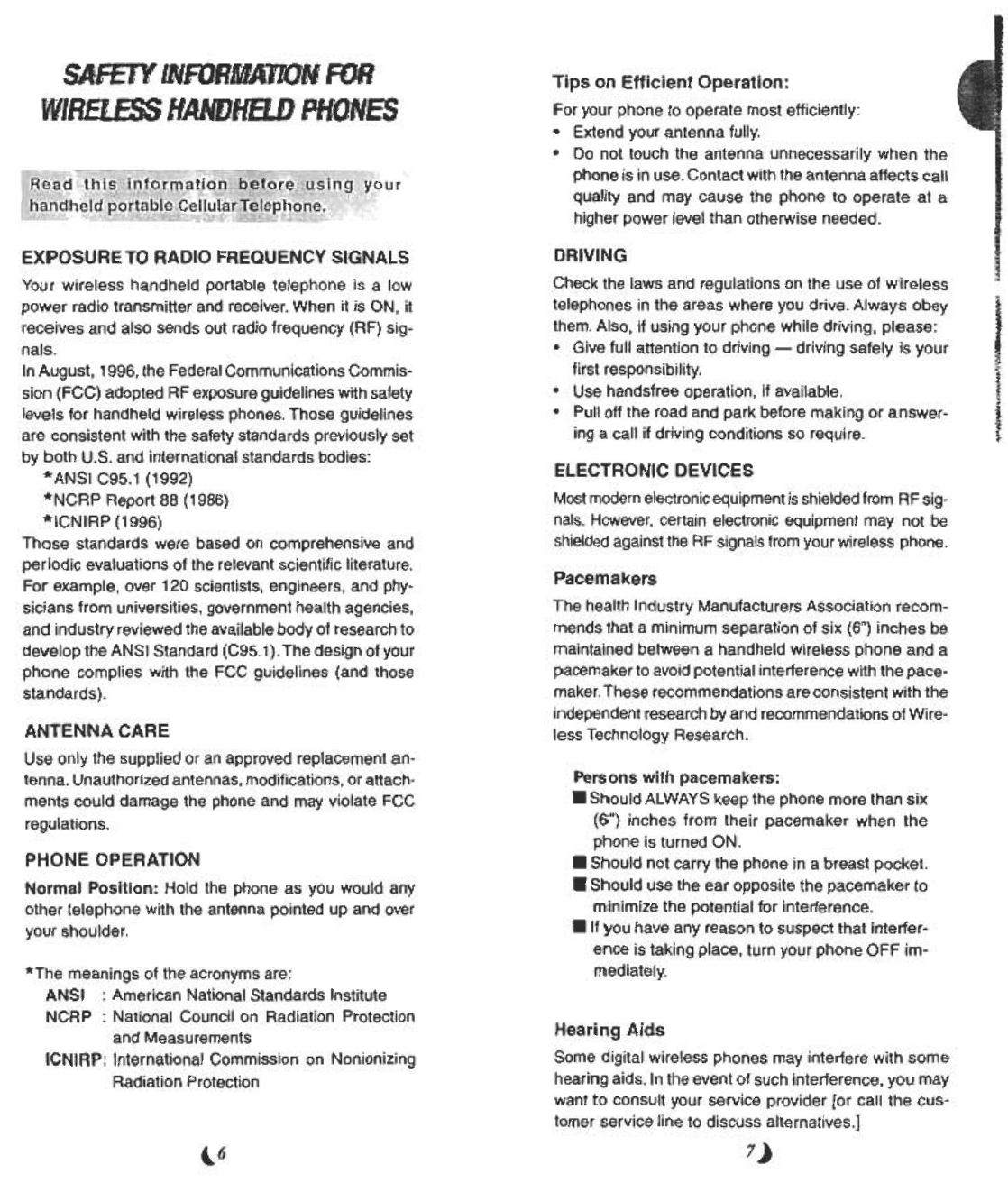
~ ..rr:rv '.Irnnllll; ~l! rnD
~ II I' lliVFUn~1 &UfI'Wi' .-vn
~l~ HANnflBD PHDM:'S' , , ' , ' , !
Tips on Efficient Operation:
For your phone to operate most efficiently:
.Extend your antenna fully.
.Do not touch the antenna unnecessarily when the
phone is in use. Contact with the antenna affects call
quality and may cause the phone to operate at a
higher power level than otherwise needed.
DRIVING
Check the laws and regulations on the use of wireless
telephones in the areas where you drive. Always obey
them. Also, if using your phone while driving, please:
.Give full attention to driving -driving safely is your
first responsibility.
.Use handsfree operation, if available.
.Pull off the road and park before making or answer-
ing a call if driving conditions so require.
ELECTRONIC DEVICES
Most modern electronic equipment is shielded from RF sig-
nals. However, certain electronic equipment may not be
shielded against the RF signals from your wireless phone.
EXPOSURE TO RADIO FREQUENCY SIGNALS
Your wireless handheld portable telephone is a low
power radio transmitter and receiver. When it is ON, it
receives and also sends out radio frequency (RF) sig-
nals.
In August, 1996, the Federal Communications Commis-
sion (FCC) adopted RF exposure guidelines with safety
levels for handheld wireless phones. Those guidelines
are consistent with the safety standards previously set
by both U.S. and international standards bodies:
* ANSI C95.1 (1992)
*NCRP Report 88 (1986)
*ICNIRP (1996)
Those standards were based on comprehensive and
periodic evaluations of the relevant scientific literature.
For example, over 120 scientists, engineers, and phy-
sicians from universities, government health agencies,
and industry reviewed the available body of research to
develop the ANSI Standard (C95.1 ). The design of your
phone complies with the FCC guidelines (and those
standards).
Pacemakers
The health Industry Manufacturers Association recom-
mends that a minimum separation of six (6") inches be
maintained between a handheld wireless phone and a
pacemaker to avoid potential interference with the pace-
maker. These recommendations are consistent with the
independent research by and recommendations of Wire-
less Technology Research.
ANTENNA CARE
Use only the supplied or an approved replacement an-
tenna. Unauthorized antennas, modifications, or attach-
ments could damage the phone and may violate FCC
regulations.
Persons with pacemakers:
.Should ALWAYS keep the phone more than six
(6") inches from their pacemaker when the
phone is turned ON.
.Should not carry the phone in a breast pocket.
.Should use the ear opposite the pacemaker to
minimize the potential for interference-
.If you have any reason to suspect that interfer-
ence is taking place. turn your phone OFF im-
mediately.
PHONE OPERATION
Normal Position: Hold the phone as you would any
other telephone with the antenna pointed up and over
your shoulder.
Hearing Aids
Some digital wireless phones may interfere with some
hearing aids. In the event of such interference, you may
want to consult your service provider [or call the cus-
tomer service line to discuss alternatives.]
7j
*The meanings of the acronyms are:
ANSI : American National Standards Institute
NCRP : National Council on Radiation Protection
and Measurements
ICNIRP: International Commission on Nonionizing
Radiation Protection
l6
